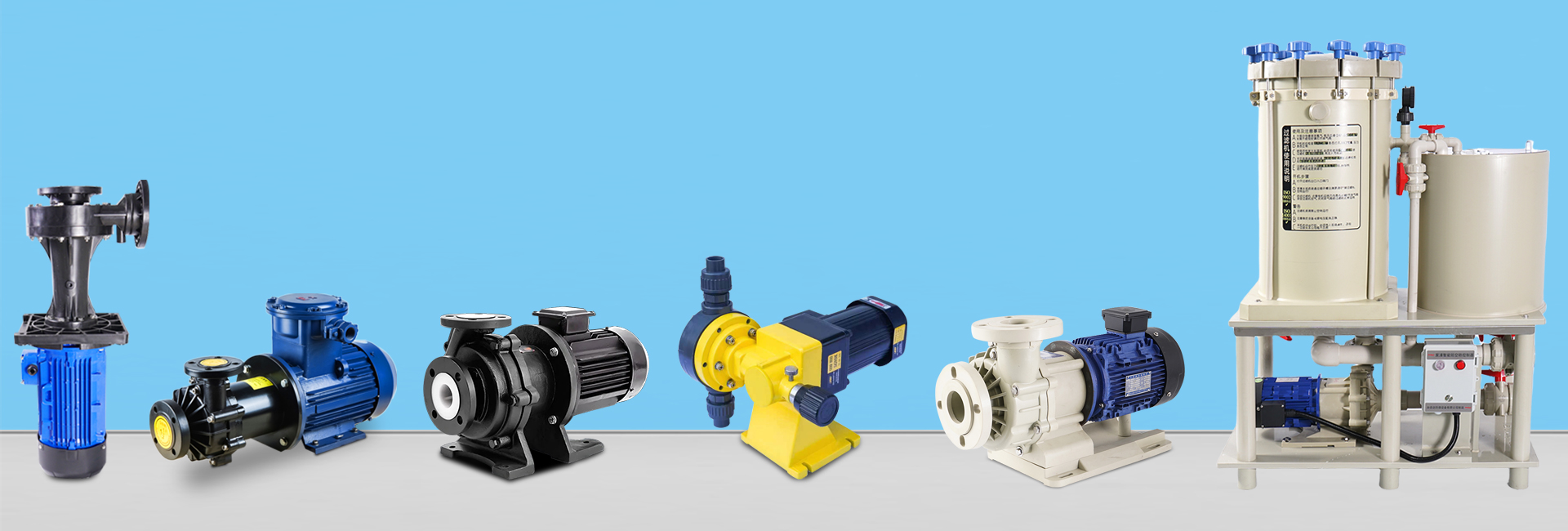In the selection of magnetic drive pumps, the material of the pump casing, impeller, and containment shell is a crucial decision factor.
Fluoroplastic materials (such as PTFE and FEP) and stainless steels (mainly 304 and 316L) differ greatly in corrosion resistance, mechanical strength, and operating adaptability.
Choosing the wrong material may not only shorten equipment life but can also lead to serious safety risks in chemical fluid transfer systems.

1. Material Characteristics: From Molecular Structure to Physical Performance
Fluoroplastic: Prioritizing Chemical Inertness Over Mechanical Strength
Molecular Structure:
Fluoroplastics contain a large number of C–F bonds (bond energy ≈ 485 kJ/mol), which are extremely stable and resist reaction with strong acids, bases, and oxidizers — earning PTFE the title of “King of Plastics.”
Key Features:
Outstanding chemical resistance: Stable in 98% sulfuric acid, 50% nitric acid, and 30% sodium hydroxide below 100 °C without visible corrosion.
Wide temperature tolerance: PTFE operates reliably from –200 °C to +200 °C, and FEP from –80 °C to +200 °C, suitable for both cryogenic and high-temperature conditions.
Smooth surface: Minimizes scaling and crystal adhesion, ideal for viscous or crystallizing fluids like caustic soda or resin.
Limitations:
Low mechanical strength: Shore hardness D50–60, poor impact resistance, and prone to cracking under external force.
High thermal expansion: About 10× greater than stainless steel, leading to deformation and reduced efficiency under high temperatures.
Low wear resistance: Not suitable for abrasive media; impeller and casing may scratch when pumping fluids with solid particles.
Stainless Steel: Strength and Stability With Conditional Corrosion Resistance
Alloy Composition:
304 stainless steel contains 18% Cr and 8% Ni.
316L stainless steel adds 2–3% Mo, significantly enhancing resistance to chloride ion corrosion.
Key Features:
High mechanical strength: Tensile strength ≥ 480 MPa; Brinell hardness 140–180; excellent impact and abrasion resistance.
Thermal stability: Low expansion coefficient (16 × 10⁻⁶ / °C) and structural integrity up to 400 °C.
Hygienic and polishable: Surface roughness ≤ Ra 0.8 µm; compliant with FDA and GMP standards for food and pharmaceutical industries.
Limitations:
Limited chemical resistance: 304 steel cannot handle >10% sulfuric acid or any hydrochloric acid; 316L resists ≤ 5% HCl but fails in concentrated nitric acid (>65%).
Risk of intergranular corrosion: Poor welding or long-term operation at 450–850 °C can cause carbide precipitation, reducing corrosion resistance.
2. Application Matching: Selecting the Right Pump for the Right Medium
Fluid Type: Corrosiveness Is the Key
Fluoroplastic Magnetic Drive Pump — For highly corrosive fluids, such as:
Strong acids: 98% H₂SO₄, 65% HNO₃, 37% HCl, hydrofluoric acid (requires reinforced PTFE).
Strong bases: 50% NaOH, 30% KOH, ammonia water.
Organic solvents: Methanol, ethanol, acetone, carbon tetrachloride, ethyl acetate.
Stainless Steel Magnetic Drive Pump — For neutral or weakly corrosive fluids, such as:
Neutral fluids: Tap water, purified water, cooling circulation water.
Mildly corrosive fluids: ≤ 5% sulfuric acid, ≤ 10% NaOH, seawater (316L).
Hygienic fluids: Juice, milk, purified water, pharmaceutical liquids (316L polished finish).
Fluid Conditions: Particle Content, Viscosity, and Temperature
With particles (> 0.1 mm):
Prefer 316L stainless steel magnetic pumps for durability.
If particles are present in a corrosive medium, install a 100-mesh inlet filter and use reinforced PTFE (carbon fiber–filled) pumps.High viscosity fluids (> 100 cP):
Choose fluoroplastic pumps due to their non-stick surface.
For low viscosity (< 100 cP), select based on corrosion resistance instead.Temperature:
Low temperature (< –40 °C): Use PTFE magnetic pumps (steel may embrittle).
Medium temperature (–40 °C to +200 °C): Either type works; decide by corrosion level.
High temperature (> 200 °C): Select 316L stainless steel pumps, as fluoroplastics deform under heat.
Industry-Specific Scenarios
| Industry | Recommended Pump Type | Reason / Standard |
|---|---|---|
| Chemical & Electroplating | Fluoroplastic magnetic pump | Resistant to strong acids & alkalis; compliant with GB/T 37241 safety standards. |
| Food & Pharmaceutical | 316L stainless steel pump | Meets FDA/GMP hygiene standards; electropolished interior prevents residue. |
| Water Treatment & Environmental | 304 SS or fluoroplastic | 304 SS for standard wastewater; fluoroplastic for acid/alkaline waste (e.g., plating, dyeing). |
3. Common Selection Mistakes and How to Avoid Them
Mistake 1: “Stainless Steel Is Always Corrosion-Resistant.”
Solution:
Always check compatibility in a Corrosion Data Handbook or perform a 48-hour immersion test before selection.
If the fluid contains chloride ions (e.g., seawater, HCl), only 316L stainless steel is acceptable — never use 304.
Mistake 2: Ignoring the Mechanical Limits of Fluoroplastic Pumps
Solution:
Fluoroplastic pumps are rated for ≤ 1.6 MPa.
For higher pressures, choose a dual-structure pump — fluoroplastic lining + stainless steel shell — to combine corrosion resistance and pressure durability.
Ensure the system includes pipeline supports to reduce vibration and impact on the pump body.
Mistake 3: Overlooking Maintenance Space in Compact Installations
Solution:
Fluoroplastic pumps weigh only one-third of stainless steel units, ideal for tight spaces.
If a stainless steel pump is required, select a vertical design to save floor space and reserve adequate maintenance clearance for future servicing.
4. Conclusion: Choosing the Right Material for Long-Term Reliability
When selecting between fluoroplastic and stainless steel magnetic drive pumps, consider corrosion level, temperature, and mechanical load as the primary factors.
For highly corrosive or hazardous fluids, fluoroplastic magnetic pumps (PTFE/FEP) deliver superior chemical stability and leak-free performance.
For high-pressure, abrasive, or hygienic applications, 316L stainless steel pumps ensure mechanical strength, safety, and cleanliness.
By combining chemical compatibility analysis, operating condition assessment, and lifecycle cost evaluation, engineers can achieve an optimized, safe, and durable pumping solution for any industrial fluid system.







